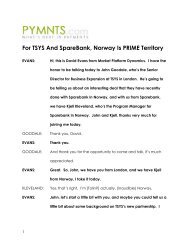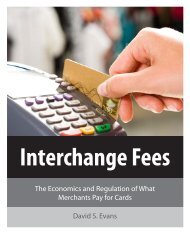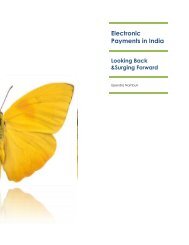Lydian Payments Journal - PYMNTS.com
Lydian Payments Journal - PYMNTS.com
Lydian Payments Journal - PYMNTS.com
You also want an ePaper? Increase the reach of your titles
YUMPU automatically turns print PDFs into web optimized ePapers that Google loves.
adopt pricing based on the payment instrument used. However, consumers and merchants are worse off<br />
when consumers without liquidity constraints use credit cards because they do not receive the proper<br />
price incentives, resulting in use of a less efficient payment instrument.<br />
Conclusion<br />
In summarizing the payment card literature, we find that no one model is able to capture all the essential<br />
elements of the market for payment services. It is a <strong>com</strong>plex market with many participants engaging in a<br />
series of interrelated bilateral transactions. Moreover, appropriate pricing arrangements for payment<br />
instruments is difficult, since payment networks are subject to large economies of scale and give rise to<br />
strong usage and adoption externalities. Much of the debate over various payment card fees is concerned<br />
with the allocation of the surpluses from consumers, merchants, and banks, as well as who is able to extract<br />
surpluses from whom.<br />
We are able to draw the following conclusions. First, a side payment between the issuer and the acquirer<br />
may be required to get both sides on board. There is no consensus among policymakers or economists on<br />
what constitutes an efficient fee structure for card payments. Second, while consumers generally react to<br />
price incentives at the point of sale, merchants are reluctant to charge higher prices to consumers who<br />
benefit from card use. Third, network <strong>com</strong>petition may not improve the price structure but may<br />
significantly reduce the total price paid by consumers and merchants. Fourth, consumers and merchants<br />
both value credit extended by credit card issuers (along with other benefits such as security), and<br />
consumers and merchants are willing to pay for it.<br />
Sound public policy regarding payment fees is difficult. The central question is whether the specific<br />
circumstances of payment markets are such that intervention by public authorities can be expected to<br />
improve economic welfare. Efficiency of payment systems is measured not only by the costs of resources<br />
used, but also by the social benefits generated by them. While the theoretical literature on payment cards is<br />
growing, there are still too few empirical investigations to guide policymakers. We hope that recent<br />
regulatory changes in different parts of the world will generate rich sets of data that can be exploited by<br />
economists to test how well the theories fit the data.<br />
© 2009. Copying, reprinting, or distributing this article is forbidden by anyone other than the publisher or author. 23








